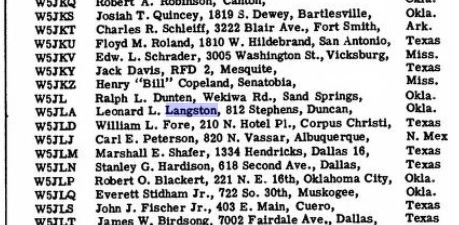
Wednesday 12:44 AM
| Public Links |
|---|
| - CenTex NWS Alerts |
| Synapse Misfires |
|---|
| - Eww, That Smell |
| - Here Ya Go! |
| - Texas Weather |
| - Takes a Village |
| - It Was Vewy Quiet |
| - TPWD Geocaching |
| Not Logged In |
| Originals |
|---|
| - On Photography |
| Not Logged In |
| Topical Collections - My Online Memory |
|---|
| - HippoFan Geocaching |
| - Home Automation |
| - 3D Printing |
| - Build Your Own Server |
| - Amateur Radio |
| - Daily Compute |
| - Recreational Vehicles |
| - Drones |
| - Live Streaming |
| - Smokers |
| - Woodworking |
| Not Logged In |
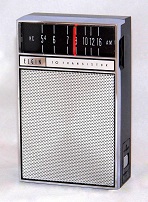 The Beginning, Radio as a very young person
The Beginning, Radio as a very young personIt seems like I have always had radios around. One of my first garage sale purchases in elementary school was a $0.10 transistor radio that had no back cover, ran on a single AA battery, and looked something like this. I remember the cheap, hard plastic ear bud from Radio Shack (along with their free battery of the month club), how uncomfortable it was to wear for any length of time and how poor the sound was. But to be able to listen to my Cardinals in the 1968 World Series (while sitting in class trying not to attract attention) was nothing short of magic.
The neighborhood kids all played with the walkie talkies of the day, most were more enthusiastic about the space or military-styled plastic made to look like our heroes on the TV instead of the quality of transmission or reliability. Thank goodness for Radio Shack's free batteries.
Those were all toys, regardless of the make and model, and none of us were interested in using them for anything serious. Roger, Over and Out.
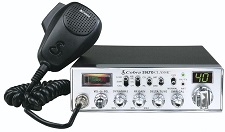
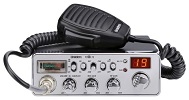 The early (to me) CB World
The early (to me) CB WorldThe 1970s brought CB radios into the forefront in a major way, possibly driven by the oil shortage and the side effects of the federal speed limit reduction to 55 miles per hour, so naturally my buddy Gary and I had to get 'em. I had a basic 23 channel model in my LTD. It was okay, but Gary's Cobra 29 was the one we all really wanted. Movies like Convoy and Smokey and the Bandit went a long way to reinforce the cool factor.
Hey, it was the mid to late '70s, anything was better than disco!
Some of the guys played with the "linear amplifiers" so they could reach all the way down I-10 from Baytown to Beaumont. I never did of course, a minimum wage of less than $2 prevented such extravagant purchases. We experimented with microphones and learned that the right way to hold a mic was to the side of your mouth turned 90 degrees to avoid sounding like Darth Vader making a prank phone call.
I spent a lot of time on the road with that CB along for company. Driving from Baytown to Port Neches, to College Station and Tulsa. It kept me awake for countless nights headed back to school, or home to recover from a week of finals.
I kept that old CB in a couple of cars through college with a magnetic roof mount. Learned a bit about weak antennas along the way. My CB use gradually tapered off to little more than the occasional "I wonder if this old thing still works". But that magmount was good reinforcement of the material covered in a couple of my classes.
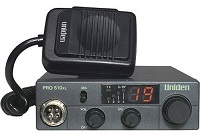 Fast forward to 1995 - Later CBs, as more of an adult and in "real life"
Fast forward to 1995 - Later CBs, as more of an adult and in "real life"I bought my second Ford Ranger pickup in the mid-90s shortly after finding my original CB packed away in a box. Rangers don't have much room under the dash for such a big box, but I found the Uniden PRO510XL to be a pretty nice fit. Technology had pleasantly advanced since the last time I looked at CB radios, and the thing was only about $40. Bought a new magnetic antenna mount and hooked it all up with a nice noise filter on the power lead. The day of the installation, I put the antenna on the roof and took off on a Sunday drive to see what was on the airwaves. We lived 6 or 7 miles east of I-35, north of Austin, Texas. For the first few miles I could find nothing on any channel and was starting to doubt that the thing worked at all. As I got closer to I-35 I could hear surges in the noise that seemed to be in patterns as if something was happening. When I could finally hear human voices they were so hard to understand I was convinced the radio was simply a dog. But about a mile from the Interstate I realized the people on channel 19 were speaking Spanish, right there on the NAFTA highway. Like technology, this was something else that had changed since my early days with the CB.
We didn't travel much in the Ranger so there wasn't much road time using the CB. It was mostly something to distract me during the commute.
 Now Skip to late 2000 or early 2001
Now Skip to late 2000 or early 2001I bought my real truck [because "real trucks" don't have spark plugs] late in the summer of 2000 to tow a fifth wheel for our state park and ocean front vacations. And since you're reading this you already know that diesel trucks and CB radios go together like bisquits and gravy. The hitch was the first add-on to the truck, and the CB was added right after the chip. The truck was a crew cab with a bench/folding console in front so adding a box even as small as the Pro510XL would probably lead to torn jeans and scratched knees during a full passenger load. It was about that time Cobra came out with their panel mounted and easily removable, almost-everything-in-the microphone radio. I ran a more permanent antenna to the back window, put a small hole under the cup holder for the bulkhead mount, and used that Cobra on many vacations for years.
For a short while I continued to use the Pro510XL and magmount when we took the other vehicle on ski trips or other long roadtrips.
It worked well but the language used by too many truckers kept me from leaving it on with young people in the car. I could go on about that for a long time, but if you've CB'd you already understand it's not a family environment in any way.
How about the "Family Radio Service" bands? We always felt it necessary to to keep the splintered groups in touch on the ski slopes, or on the hiking and mountain-biking trails, or between cars travelling in a convoy on a long road trip. This relatively new technology (Wiki: 1996) seemed to meet the needs. Blisterpacks of paired units were common and most could be set to the same "privacy codes" as other brands for talking to each other. But the "privacy codes" didn't add privacy, and since most of our people never bothered to learn anything about them, the comms existed but were frequently less than desirable.
On the road our caravans to Colorado for skiing used FRS radios to discuss rest breaks, meal choices, departure coordination when the meal preferences were incompatible, etc. We also used them late at night for trivia games to keep the drivers awake.
Once the right channels were shared and setup properly it was a pretty good solution. Nothing really, but the stories above are how I got to where I am now. Well, almost. Now we get to the precipitating factor.
Nothing really, but the stories above are how I got to where I am now. Well, almost. Now we get to the precipitating factor.Ever since we moved to the Pacific north west I have become more aware of the everyday dangers inherent in a rainy, hilly/mountainous environment where few things are as stable as the ground was in virtually all of Texas. Up here we have rare earthquakes, frequent mudslides, routine flooding, and daily tree branches or trees across the roads. We live in a small town where our cellular coverage is very weak. My Sprint-connected iPhone tells me it's running at 1x outside the house when it has signal. We took easy communications for granted until moving here, now we need a Sprint Air Rave as our own local access point. It reaches most of the way to the street and probably about to the edge of each neighbor's house, but it requires an internet connection to function. Our internet service is delivered via cable, and those trees/floods/high winds and other routine natural events impact the cable on a regular basis, and when the power and cable are out, we are isolated right in the middle of the neighborhood.
All of this has been percolating around my skull for the last few months as we've discussed vacations to the Grand Canyon. Hiking of that caliber requires more thoughtful preparation than how much water to carry, and reading blogs and watching videos on such things led me back to HAM radio. We are also planning a snowmobile trip in the backcountry, and with the Grand Canyon trip it felt like time to purchase of a couple of handheld VHF/UHF/FM/WX radios.
Note: They are essentially software defined radios supporting specific bands. They can do a LOT of things, even at $32 each!
I'm not a special tool kind of guy, I generally want my tools and toys to do a lot of things, so having a UHV/VHF radio just for emergencies seems wasteful. So I set them up to receive the NOAA weather stations. Then I set them up to monitor my FRS radios (it's illegal for the new ones to transmit on FRS frequencies except in case of an emergency), and the FM tuning capability is a bonus.
The units I bought are fairly complicated and the manufacturer's documentation is lacking, to be kind. I have dug and explored and found some really good resources that I have been using and will continue to rely on. You may also find them useful.
I have benefited in many ways from the internet's copious How-To infrastructure since well before Linux ever hit the world stage. Along that same path I would like to provide that level of step-by-step How-To process to help you enter the wide world of Amateur Radio with a lot less fumbling and stumbling than I wandered through. That's the whole point of my Quick Start Guide.
Please enjoy it in good health.|
"It challenges the imagination to wonder productively what will be the political declamations at the Democratic convention in 2008 if the Democrats are to be the party that kicked out sitting Sen. Joe Lieberman six years after he was named their vice presidential candidate, notwithstanding that 90 percent of his Senate votes have been with his party, opposing President Bush." - William F. Buckley |
| Geek Humor |
|---|
| while (!(succeed=try())); |
| Regular Reading |
|---|
| Blogs and RSS Feeds |
| Special Archives |
| People of The Son |
| People of the Gun |
| Groups of the Gun |
| People of the Hack |
| Legal Eagles |
| Mine, all Mine |
An exercise in truly free free-speech. No license required, no training wheels available.
"When words lose their meaning, people will lose their liberty." -- Confucius
vincit omnia veritas
